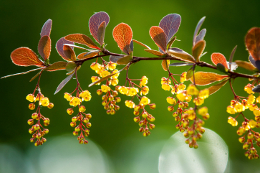Barberry shrubs are often used to enhance garden or landscape areas. But to keep them looking beautiful, you need to know how to maintain them. This Buzzle article tells you more about this colorful and attractive shrub and its maintenance.

Did You Know?Barberry can be of great medicinal use. It is used to treat skin infections, psoriasis, gastritis, ulcers, diarrhea, gallstones and inflammation of gall bladder, and even malaria. It is also effective in cleansing the liver, correcting anemia, and in treating hangovers.Barberry shrubs or bushes, also known as
berberis or
pepperidge bushes, belong to a genus that contains about 450―500 different species of deciduous and evergreen shrubs. They are known for their thorny 'barbs' and wiry branches, and hence, the name
'Barberries'. They are often used as fencing or for setting boundaries between yards. The
Japanese barberry is one of the most common barberry shrubs grown in landscapes.
They are hard, woody, and deciduous shrubs. They bear bright yellow, fragrant flowers in spring. These flowers hang from the stem like a tear drop. The leaves of the barberry plant are small and oval-shaped with a fine texture. The attractive foliage with different colors from bright green to burgundy and gold, make barberries useful in landscaping. These shrubs are slow growers and grow steadily in a semi-spreading fashion. Most bushes grow to a height of 10 feet; however, there also exist some dwarf shrubs. They are extremely sturdy and grow even in harsh conditions. They thrive in USDA hardiness zones 4 through 8.
Barberry shrubs have a uniform growth, and hence, require very little maintenance. This is the main reason why barberries are often planted by garden owners as hedges or natural fences. A little bit of trimming and pruning at regular intervals is required for proper growth, as in case of any other shrub.
PruningBarberry shrubs are decorative plants that are often used for landscaping. No one wants their shrubs to be grown out of control and in unwanted places. Hence, it becomes very important to trim or prune these shrubs timely. But for that, one should know when and how to prune your beautiful-looking shrub.
When to Prune Barberry Shrubs?Pruning the barberry bushes yearly is important to aid in better growth and blooming. They produce fruits or berries that create seedlings. It is recommended that you prune the shrubs after they have fruited, during fall or winter. Dead woods should be removed during summer months, and the bushes should be pruned in the period between mid winter to late winters, i.e., before spring.
According to the University of Minnesota Extension, barberry bushes should be trimmed at the time of planting. This is important as it encourages the shrub to develop a strong structure. The shrubs should be trimmed to six inches from the ground, and the diseased or damaged branches should be removed. This helps in encouraging healthy fruit and flower development. The first two years after planting are important for shaping up the barberry shrub or hedge.
If the shrub is old, leggy, or overgrown, then severe pruning is recommended, i.e., to cut back the older stems to the ground. It encourages dense and bushy growth of the plant.
How to Prune Barberry Shrubs?Pruning these shrubs is not a very difficult task! Put on your safety glasses, heavy work gloves and other protective gear, and get started. The tools needed to prune barberry plant include pruning shears and long handled loppers. You will also need a nylon rope and a plastic drop sheet.
Start pruning your barberry bush to the height, width, and shape that you desire. You can wrap the obstructive branches in the plastic drop cloth and secure it with nylon rope till you trim the other branches.
Check for new sprouting plants and pull them out from the roots. Put all the pruning waste in a drag bag. Do not leave it on the ground as it may give rise to new growth. And last but not the least, protect yourself from the thorns of the barberry bush!
These colorful shrubs not only serve as hedge plants, but also create a nice backdrop for other plants in your garden. However, they require proper care and maintenance like any other garden plant.
Happy gardening!






 Did You Know?Barberry can be of great medicinal use. It is used to treat skin infections, psoriasis, gastritis, ulcers, diarrhea, gallstones and inflammation of gall bladder, and even malaria. It is also effective in cleansing the liver, correcting anemia, and in treating hangovers.Barberry shrubs or bushes, also known as berberis or pepperidge bushes, belong to a genus that contains about 450―500 different species of deciduous and evergreen shrubs. They are known for their thorny 'barbs' and wiry branches, and hence, the name 'Barberries'. They are often used as fencing or for setting boundaries between yards. The Japanese barberry is one of the most common barberry shrubs grown in landscapes.
Did You Know?Barberry can be of great medicinal use. It is used to treat skin infections, psoriasis, gastritis, ulcers, diarrhea, gallstones and inflammation of gall bladder, and even malaria. It is also effective in cleansing the liver, correcting anemia, and in treating hangovers.Barberry shrubs or bushes, also known as berberis or pepperidge bushes, belong to a genus that contains about 450―500 different species of deciduous and evergreen shrubs. They are known for their thorny 'barbs' and wiry branches, and hence, the name 'Barberries'. They are often used as fencing or for setting boundaries between yards. The Japanese barberry is one of the most common barberry shrubs grown in landscapes.